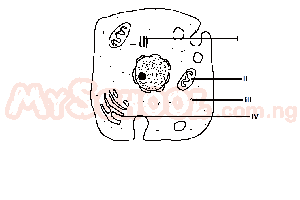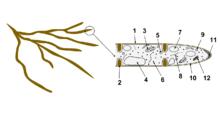Year :
2004
Title :
Biology
Exam :
JAMB Exam
Paper 1 | Objectives
1 - 10 of 50 Questions
| # | Question | Ans |
|---|---|---|
| 1. |
 The endoplasmic reticulum is represented by the part labelled A. I B. II C. III D. IV |
D |
| 2. |
 The part labelled II is responsible for A. photosynthesis B. respiration C. protein synthesis D. excretion |
B |
| 3. |
The rods in the retina of the eyes are examples of A. cells B. tissues C. organs D. systems |
A |
| 4. |
The absence of special food and water-conducting systems restricts the body size in A. algae, liverworts and mosses B. liverworts, mosses and ferns C. the bryophytes and the pteridophytes D. the thallophytes and pteridophytes |
A |
| 5. |
A plant-like feature in Euglena is the A. pellicle B. pigment spot C. large spot D. gullet |
B |
| 6. |
The most common characteristic of the fungal hyphae is the possession of A. cell-like compartment with one nucleus each B. cell walls that are both rigid and chitinous C. a multicellular mycelium in the substrate D. cell-like partitions formed by cross-walls Detailed Solution
- A hypha has cross-walls which divide it into cell-like compartments that contain several nuclei NB: A rigid cell wall is not present in slime moulds. |
|
| 7. |
Insects are considered the most successful among the invertebrates because they? A. possess exoskeletons B. survive in various environmental conditions C. have wings for flight D. possess the ability to change their forms Detailed SolutionIt is believed that insects are so successful because they have a protective shell or exoskeleton. |
|
| 8. |
The larval stage of a mosquito is called A. wriggler B. grub C. maggot D. caterpillar |
A |
| 9. |
The function of the long-winged reproductives of the termites colony is to A. disperse the population B. feed the young C. participate in swarming D. protect the young |
A |
| 10. |
A peculiar characteristics of mammals is that they A. have teeth B. are warm-blooded C. have lungs D. have sabaceous glands |
D |
| 1. |
 The endoplasmic reticulum is represented by the part labelled A. I B. II C. III D. IV |
D |
| 2. |
 The part labelled II is responsible for A. photosynthesis B. respiration C. protein synthesis D. excretion |
B |
| 3. |
The rods in the retina of the eyes are examples of A. cells B. tissues C. organs D. systems |
A |
| 4. |
The absence of special food and water-conducting systems restricts the body size in A. algae, liverworts and mosses B. liverworts, mosses and ferns C. the bryophytes and the pteridophytes D. the thallophytes and pteridophytes |
A |
| 5. |
A plant-like feature in Euglena is the A. pellicle B. pigment spot C. large spot D. gullet |
B |
| 6. |
The most common characteristic of the fungal hyphae is the possession of A. cell-like compartment with one nucleus each B. cell walls that are both rigid and chitinous C. a multicellular mycelium in the substrate D. cell-like partitions formed by cross-walls Detailed Solution
- A hypha has cross-walls which divide it into cell-like compartments that contain several nuclei NB: A rigid cell wall is not present in slime moulds. |
|
| 7. |
Insects are considered the most successful among the invertebrates because they? A. possess exoskeletons B. survive in various environmental conditions C. have wings for flight D. possess the ability to change their forms Detailed SolutionIt is believed that insects are so successful because they have a protective shell or exoskeleton. |
|
| 8. |
The larval stage of a mosquito is called A. wriggler B. grub C. maggot D. caterpillar |
A |
| 9. |
The function of the long-winged reproductives of the termites colony is to A. disperse the population B. feed the young C. participate in swarming D. protect the young |
A |
| 10. |
A peculiar characteristics of mammals is that they A. have teeth B. are warm-blooded C. have lungs D. have sabaceous glands |
D |
